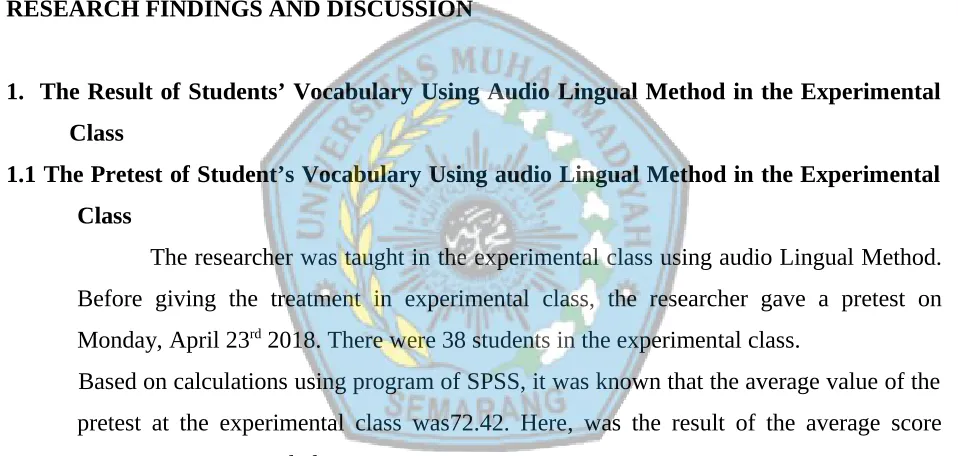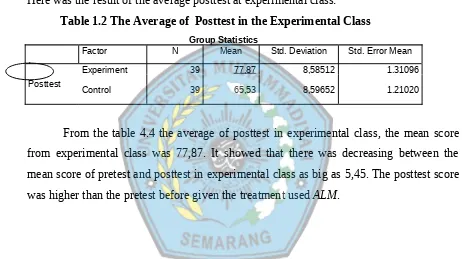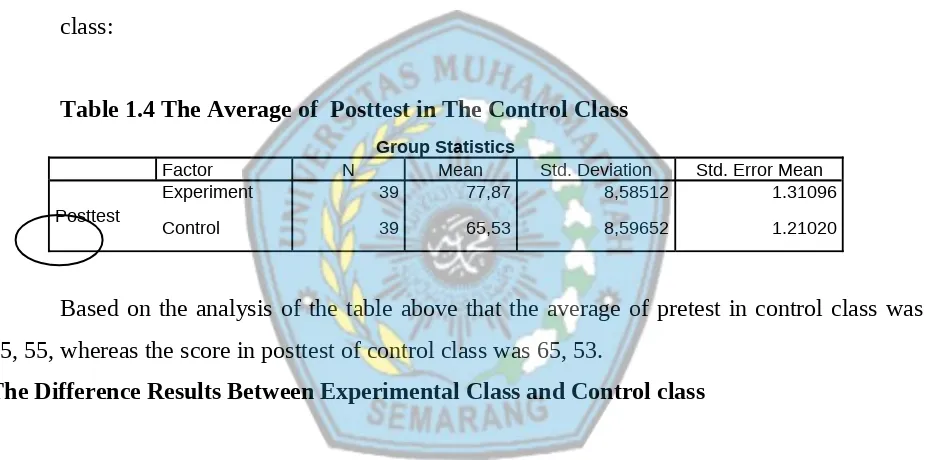THE IMPLEMENTATION OF AUDIO LINGUAL METHOD
TO ENRICH STUDENTS’ VOCABULARY
OF MTs FUTUHIYAH DEMAK
Manuscript
by
Desi Tri Wahyuni I2B011005
ENGLISH EDUCATION DEPARTMENT
FACULTY OF FOREIGN LANGUAGE AND CULTURE
UNIVERSITY OF MUHAMMADIYAH SEMARANG
APPROVAL
A manuscript by Desi Tri Wahyuni, 2018 for a final project entitled “The Implementation of Audio Lingual Method to Enrich Student’s Vocabulary of MTS Futuhiyah Demak ” has been
approved by the both advisors on August 2018
Advisor I
Dr. Dodi Mulyadi, S.Pd., M.Pd. NIK. 28.6.1026. 203
Advisor II
THE IMPLEMENTATION OF AUDIO LINGUAL METHOD TO ENRICH STUDENTS’ VOCABULARY
OF MTs FUTUHIYAH DEMAK
Penerapan Metode Audio Lingual untuk Menambah Vocabulary Siswa di MTS Futuhiyah Demak
Desi Tri Wahyuni1 , Dodi Mulyadi2 , Muhimatul Ifadah3
English Education Department Faculty of University of Muhammadiyah Semarang Jl. Kedungmundu Raya No. 18 Semarang
ABSTRACT
Nowadays, students still though how difficult to learn English Language. They often found difficult for conducting english activity. The English activity include speaking, listening, writing and reading. Those activities need involve English vocabulary. Looking at the reason the researcher helped their problems by implementing of Audio lingual method to teach the student’s vocabulary. Furthemore, this reseach was aimed to know the implementation of ALM, know enhancement of student’s vocabulary, to find out the student particiaption about the method applied. The researcher was disigned by using experimental reseach at Second grade of MTS Futuhiyah Demak. In addition, the researcher used some techniques to collect the data wich were observation, questionnaire, and test. The test result of student’s vocabulary had significant enhancement, wich showed the result of pre test score of experimental class was 72,42 and post test was 77,87. Meanwhile the result of pretest score of control class was 55,55 and post test was 65,53. More over, the student became active and creative during participate in learning material. They were also been able to imitate the models from the material in front of class. They were onjoyed with this activity because they were directly can enrich their vocabulary and also englsih skill.
INTRODUCTION
Vocabulary is the main element of language. According to Nation (2008:66) says that vocabulary is the central to language. In an EFL classroom, according to Carpenter & Olson (2011), vocabulary is needed for expressing meaning and conveying thoughts through both receptive and productive skills. When people, in this study student do a communication, they use vocabularies that will be arranged into a sentence that has full of meaning.
According to Kurikulum Tingkat Satuan Pendidikan 2006 (KTSP, 2006: 278) the aim of the English teaching in Indonesia especially teaching English to Junior High School is to enable students to have the ability in developing communicative competence in both oral and written form in achieving functional literacy level, to have the awareness about the essence and the important of English in increasing competition in global community and the last is developing the students’ comprehension about interrelatedness between language and culture.
For supporting the goverment program, each scholl try any learning method that will be accepted by student in learning English processes. We realize that English as foreign language for student is important to mastery. but how do the students communicate in English (as their foreign language) to others if they still have lack of vocabulary? We should consider that communication requires of vocabularies. Vocabulary is the core component of language proficiency and provides much of the basis for how well learners speak, listen and write (Richard 2002:255). The need to enrich vocabulary for students is very important. This is because with many vocabularies that students’s mastery, it will be easier for students in using English skill in their daily activities, both communication, writing and listening. the opposite, without enough vocabulary, we would face so much difficulty in doing their english activities. Here, vocabulary is primary the role and is being needed.
There are many strategies, which can be used by English teachers that will be effectively enriching their students’ foreign vocabulary. One of the methods will be discussed in this study. Here, Audio Lingual Method has been chosen to be implemented in the experiment of this current study. The researcher expects that Audio lingual Method is able to help the students for enriching their vocabulary
language. Audio lingual method trains students in order to attain conversational proficiency in a variety of foreign language (Dwi 2012:6). Furthermore, this method is closely relating with behaviorism theory. Behaviorism theory emphasizes the existence of repetition; replacement and answer of questions to drill student’s speaking skill trough media for enrich their vocabulary. The teachers help them to learn any and all of words and phrases that assist them in enhancing their english vocabulary. Through the application of Audio lingual methode, the researchers expects students will be easier to enrich their english vocabulary.
In this research, researcher will apply Audio lingual method that it will be combined with the concept of repetition by behaviorism theory to enrich student's English vocabulary. The researcher will take the data from the population students who are in second grade of MTs Futuhiyah Demak.
The formulation of the problem in this research can be formulated as follow :
a. How is the implementation of Audio Lingual Method in teaching and learning process? b. How the students participation in learning vocabulary through Audio lingual method This research was conducted to found out:
a. To describe the implementation of Audio Lingual Method in the process of teaching of vocabulary.
b. To describe the students participationin learning vocabulary through Audio lingual method
RESEARCH METHODOLOGIES
The researcher used experimental method. The design of a single group of pretest and posttest designs can be described as follows:
Research Design
Class PRE-TEST TREATMENT POST-TEST
Experiment (A) O1 X O2
Control (B) O1 - O2
This research carried out through two classes. Each classes consists of five meetings. The population of the study was second grade of MTS Futuhiyah Demak. The researcher choosed VIII A as the experimental class and VIII B as the control class. To collect the data, this research used four data collection techniques. They were interview, observation, test and questionnaire. Observation was done during the treatment or ongoing way in this case during teaching vocabulary by using Audio Lingual Method. The interview was done after completing the treatment. Meanwhile, during the teaching, the students made amll group and they was asked to standing in front of the class to review vocabulary they’ve learned. This method conducted to see wether or not there was an improvement in their vocabulary.
RESEARCH FINDINGS AND DISCUSSION
1. The Result of Students’ Vocabulary Using Audio Lingual Method in the Experimental Class
1.1 The Pretest of Student’s Vocabulary Using audio Lingual Method in the Experimental Class
The researcher was taught in the experimental class using audio Lingual Method. Before giving the treatment in experimental class, the researcher gave a pretest on Monday, April 23rd 2018. There were 38 students in the experimental class.
Based on calculations using program of SPSS, it was known that the average value of the pretest at the experimental class was72.42. Here, was the result of the average score pretest at experimental class:
Table 1.1 The Average of Pretest in The Experimental Class
Group Statistics
Factor N Mean Std. Deviation Std. Error Mean
Pretest
Experiment 38 72,42 12,77257 .80914
Control 39 55,55 12,51949 .85053
. 1.2 The Posttest of Student’s Vocabulary using audio Lingual Method in the Experimental Class
The posttest in research was conducted to measure the increase of students’ achievement in student’s vocabulary by using Audio Lingual Method in the experimental class. Based on the calculation of average result of posttest’s score at the experimental class using SPSS program was 77,8
Here was the result of the average posttest at experimental class:
Table 1.2 The Average of Posttest in the Experimental Class
Group Statistics
Factor N Mean Std. Deviation Std. Error Mean
Posttest
Experiment 39 77,87 8,58512 1.31096
Control 39 65,53 8,59652 1.21020
From the table 4.4 the average of posttest in experimental class, the mean score from experimental class was 77,87. It showed that there was decreasing between the mean score of pretest and posttest in experimental class as big as 5,45. The posttest score was higher than the pretest before given the treatment used ALM.
2. The Result of Students’ Vocabulary Using Conventional Method in the Control Class 2.1 The Pretest of Student Vocabulary in the Control Class
The control class was a class given Conventional Method. There were 39 students in the control class. Pretest was conducted to measure the knowledge and achievement of the student’s vocabulary before given the treatment.
In addition, the result of the average pretest using program SPSS on the control class was 55,55. Here, was the result of the average value pretest at control class:
Table 1.3 The Average of Pretest in The Control Class
Group Statistics
Factor N Mean Std. Deviation Std. Error Mean
Control 39 55,55 12,51949 .85053
From the table 4.5 The researcher required the average score of the pretest in the control class before being given the treatment.
2.2 The Posttest of the Control Class
The posttest was conducted to measure the increase of students’ achievement in Student’s vocabulary by using conventional method in the control class.
The calculation result of average posttest’s value at the control class using program SPSS was 65,53. Here was the result of the average posttest value at the control class:
Table 1.4 The Average of Posttest in The Control Class
Group Statistics
Factor N Mean Std. Deviation Std. Error Mean
Posttest
Experiment 39 77,87 8,58512 1.31096
Control 39 65,53 8,59652 1.21020
Based on the analysis of the table above that the average of pretest in control class was 55, 55, whereas the score in posttest of control class was 65, 53.
The Difference Results Between Experimental Class and Control class
In obtaining the result of differences between the experimental class and the control class, this was the calculation of the difference of pretest and posttest in table form as follows:
Table 1.5 The Result from The Comparison Average of Pretest and Posttest in Control Class
3. The Result of Questionnaire in the Experimental Class
The researcher using the questionnaire which contained 20 statements. Each number had four answers, there were totally disagree, disagree, doubt, agree, and totally agree
3.1 The Results of the Questionnaire Calculation in the Experimental Class
The questionnaire was conducted on 6 August 2016. The purpose of giving this questionaire was to know the motivation of the students in experimental class while learning vocabulary and teaching English by using Audio Lingual Method.
There was scale of the percentage result qualification for giving scores of questionnaire such as 80% - 100% was very good, 61% - 80% was good, 41% - 60% was fair, 21% - 40% was poor, and 0 – 20% was very poor.
The result of the questionnaire It was the result of calculation the questionnaire scores percentage in the experimental class.
Percentage =
= = 62, 15 %
Based on the result of calculation the percentage questionnaire above, it showed that the result was 62,15%. It meant that was in the interval 61% - 80%, and it has good catagory. It explained that students in the experimental class supported learning vocabulary used ALM can help them for enriching their vocabulary.
CONCLUSION AND SUGGESTION Conclusion
Audio Lingual Method is one of technique for alternative solutions that the teacher can use to enrich student’s vocabulary. It c a n help students for enriching their vocabulary in English material.
enriching student’s vocabulary. It can be seen from the differences of average score of posttest between experimental class and controlled class before applying Audio Lingual Method in Learning Processes and after applying that method in Learning.
Based on the data from quasi experimental research at the second year students of MTS Futuhiyah 2 Mranggen, it can be seen that the students’ post test score in the experimental class is (∑X = 3.037), Mean score 77,87, which is learning vocabulary through audio Lingual Method are higher than the students’ posttest score in the control class (∑X = 2556), Mean score 65,53, so there were different score between experimental class and control class in post test was 12,34. It is indicated that students used audio Lingual Method got a better score than students who learning vocabulary without using A L M .
5.2 Suggestion
Based on the conclusion above, the researcher wants to give some suggestions that might be useful. The suggestions for English teacher that teach English material especially in Vocabulary. The teacher is hoped to be creative in teaching English in class, in order to increase teaching learning process and makes students active in learning, and Audio Lingual Method is useful in order to make students become active and help to enrich students’ vocabulary. For the students, they can use Audio Lingual method for optimally learning English especially vocabulary.
REFERENCES Refferences
Arikunto, Suharsimi. 2006. Prosedur Penelitian: Suatu Pendekatan Praktek. Jakarta: PT. RINEKA CIPTA.
Arikunto, S. 2010. Prosedur penelitian : Suatu Pendekatan Praktik. (Edisi Revisi). Jakarta : Rineka Cipta
Richard, et al. 1990. How to Design and Evaluate Research. New York: Mc.Graw Hill.Inc Richard, Jack, John Platt and Heidi Weber.1985. Longman Dictionary of Applied Linguistics.
Harlow England: Longman Group Limited.


